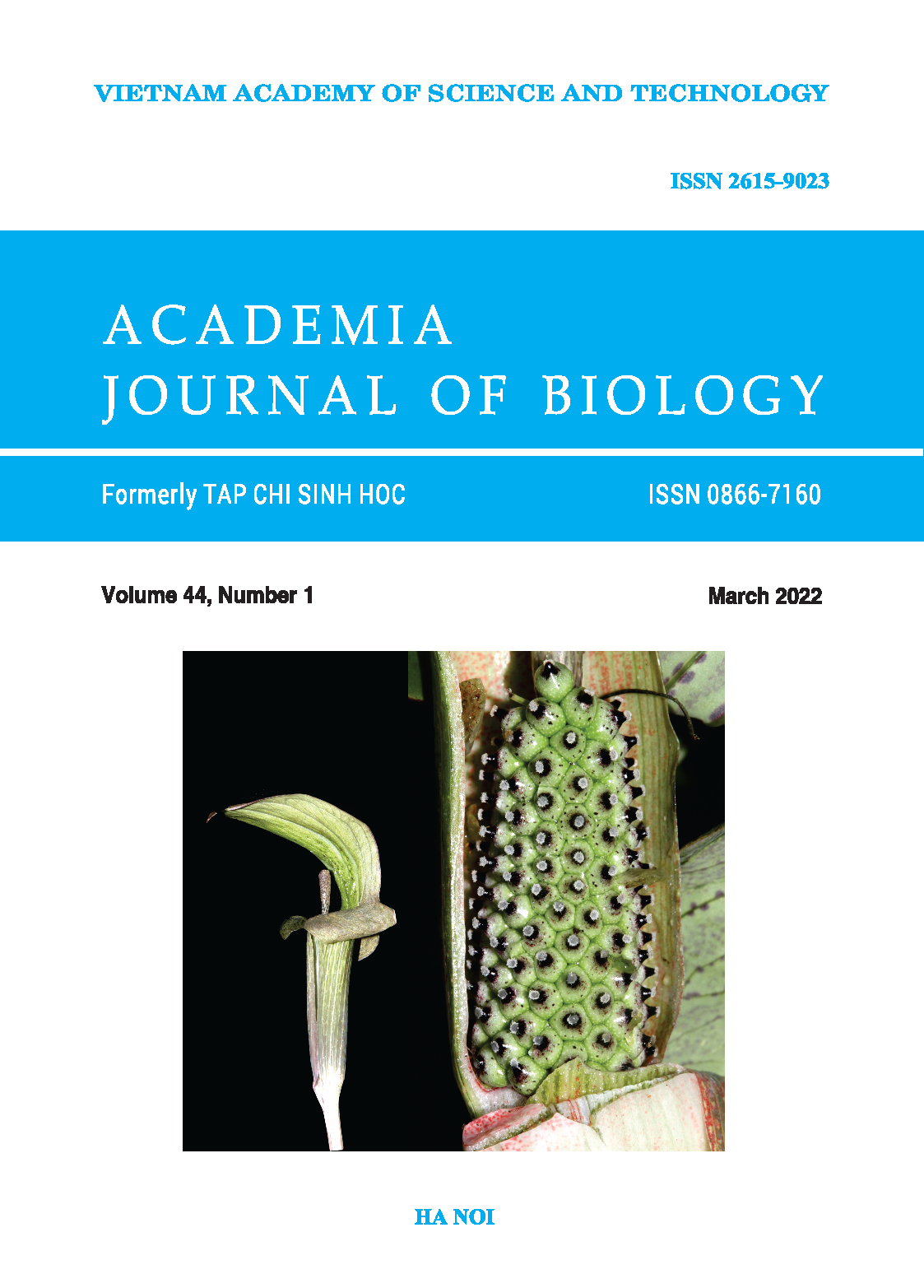Optimization of cultural conditions for omega 3-6 fatty acids and carotenoids production by \(\textit{ Schizochytrium mangrovei}\) TB17
Author affiliations
DOI:
https://doi.org/10.15625/2615-9023/16208Keywords:
Schizochytrium mangrovei, astaxanthin, carotenoid, DHA, DPA, EPA, PUFAs.Abstract
Heterotrophic marine microalgae Thraustochytrids are commonly found in marine environments, sediments, and decaying mangrove leaves. Their ability to produce high-value products such as docosahexaenoic fatty acids (DHA, C22:6 ω-3), carotenoids, and sterols has gained increasing attention. The products are widely applied in the food, pharmaceutical, and cosmetic industries. In this paper, results on the effect of culture medium on fatty acid composition and pigment content as carotenoid and astaxanthin of Schizochytrium mangrovei TB17 strain biomass were presented. The optimal growth conditions of strain TB17 in the flask were determined including the temperature of 28 oC, the salt concentration of 15‰, glucose as carbon source with the concentration of 3%, yeast extract as nitrogen source with the concentration of 1%. Dry cell weight (DCW) and lipid content of strain TB17 reached highest values of 12.61 ± 0.16 g/L; 34.17 ± 1.92% DCW, respectively, after 120 hours of culture. The content of DHA, docosapentaenoic acid (DPA, C22:5 ω-3) and eicosapentaenoic acid (EPA, C20:5 ω-3) in biomass accounted for 36.66 ± 1.63%; 11.73 ± 1.14% and 0.48 ± 0.01% of total fatty acid (TFA), respectively. The content of total carotenoid and astaxanthin reached 35.86 ± 1.52 µg/g and 7.18 ± 0.21 µg/g DCW after 120 hours of culture. Therefore, the obtained biomass of strain TB17 was sufficient to meet the demand for the production of DHA, DPA, EPA fatty acids as well as the extraction of carotenoids, especially astaxanthin for functional food and other biotechnological applications.
Downloads
Metrics
References
Aki T., Hachida K., Yoshinaga M., Katai Y., Yamasaki T., Kawamoto S., Kakizonoa T., Maokac T., Shigetaa S., Suzuki O., Ono K., 2003. Thraustochytrid as a potential source of carotenoids. J. Am. Oil. Chem. Soc., 80(8): 789–794.
Asker D., Awad T., Ohta Y., 2002. Lipids of Haloferax alexandrinus Strain TM (T): An Extremely Halophilic Canthaxanthin Producing Archaeon, J. Biosci. Bioeng., 93(1): 37–43. https://doi.org/10.1016/ S1389-1723(02)80051-2
Bligh E. G., Dyer W. J., 1959. A rapid method of total lipid extraction and purification. Can. J. Biochem. Phys., 37(8): 911–917. http://dx.doi.org/10.1139/o59-099
Bowles R. D., Hunt A. E., Bremer G. B., Duchars M. G., Eaton R. A., 1999. Long-chain n-3 polyunsaturated fatty acid production by members of the marine protistan group the thraustochytrids: screening of isolates and optimization of docosahexaenoic acid production. J. Biotechnol., 70: 193–202. http://dx.doi.org/10.1016/S0168-1656(99) 00072-3
Dang D. H., Hoang T. L. A., Ngo T. H. T., 2011. Study on biological characteristics of heterotrophic marine microalga - Schizochytrium mangrovei PQ6 isolated from Phu Quoc Island, Kien Giang province, Vietnam. J. Phycol., 47(4): 944–954. http://dx.doi.org/ 10.1111/j.1529-8817.2011.01012.x
Fan K. W., Vrijmoed L. L. P., Jones E. B. G., 2002. Physiological studies of subtropical mangrove thraustochytrids. Bot. Mar., 45: 50-57. https://doi.org/10.1515/BOT.2002. 006.
Furlan V. J. M., Batista I., Bandarra N., Mendes R., Cardoso C., 2019. Conditions for the Production of Carotenoids by Thraustochytrium sp. ATCC 26185 and Aurantiochytrium sp. ATCC PRA-276. Journal of Aquatic Food Product Technology, 28(5): 465–477. https://doi.org/10.1080/10498850.2019.1603175
Furlan V. J. M., Maus V., Batista I., Bandarra N. M., 2017. Production of docosahexaenoic acid by Aurantiochytrium sp. ATCC PRA-276. Braz. J. Microbiol., 48(2): 359–365. http://dx.doi.org/10.1016/j.bjm.2017.01.001
Galasso C., Corinaldesi C., Sansone C., 2017. Carotenoids from Marine Organisms: Biological Functions and Industrial Applications. Antioxidants, 6 (4): 96. http://dx.doi.org/10.3390/antiox6040096
Hata N., Ogbonna J. C., Hasegawa Y., Taroda H. and Tanaka H., 2001. Production of astaxanthin by Haematococcus pluvialis in a sequential heterotrophic-photoautotrophic culture. J. Appl. Phycol., 13: 395–402.
Huang T. Y., Lu W. C., Chu I. M., 2012. A fermentation strategy for producing docosahexaenoic acid in Aurantiochytrium limacinum SR21 and increasing C22:6 proportions in total fatty acid. Bioresour. Technol., 123: 8–14. http://dx.doi.org/ 10.1016/j.biortech.2012.07.068
Jiang X., Zhang J., Zhao J., Gao Z., Zhang C., Chen M., 2017. Regulation of lipid accumulation in Schizochytrium sp. ATCC 20888 in response to different nitrogen sources. Eur. J. Lipid. Sci. Technol., 119(10): 1700025. https://doi.org/ 10.1002/ejlt.201700025.
Johnson E. A., An G. H., 1991. Astaxanthin from Microbial Sources. Crit. Rev. Biotechnol., 11: 297–326. https://doi.org/ 10.3109/07388559109040622
Leaño E. M., Gapasin R. S., Polohan B., Vrijmoed L. L., .2003. Growth and fatty acid production of thraustochytrids from Panay mangroves, Philippines, Fungal. Divers., 12: 111–122. http://hdl.handle.net/10862/1969
Park H., Kwak M., Seo J., Ju J., Heo S., Park S., Hong, W., 2018. Enhanced production of carotenoids using a Thraustochytrid microalgal strain containing high levels of docosahexaenoic acid-rich oil. Bioprocess. Biosyst. Eng., 41(9): 1355–1370. http://dx.doi.org/10.1007/s00449-018-1963-7
Raghukumar S., 2008. Thraustochytrid marine protists: production of PUFAs and other emerging technologies. Mar. Biotechnol., 10: 631–640. http://dx.doi.org/10.1007/ s10126-008-9135-4
Sahin D., Tas E., Altindag U.H., 2018. Enhancement of docosahexaenoic acid (DHA) production from Schizochytrium sp. S31 using different growth medium conditions. AMB Expr., 8(1): 7. http://dx.doi.org/10.1186/s13568-018-0540-4
Strickland J. D. H., Parsons T. R., 1972. A practial handbook of seawater analysis. Fisheries Research Board of Canada, Bulletin No. 167. Hardcover - January 1, 1972.
Taoka Y., Nagano N., Okita Y., Izumida H., Sugimoto S., Hayashi M., 2009b. Extracellular enzymes produced by marine eukaryotes, thraustochytrids. Biosci. Biotechnol. Biochem., 73: 180–182. http://dx.doi.org/10.1271/bbb.80416
Taoka Y., Nagano N., Okita Y., Izumida H., Sugimoto S., Hayashi M., 2009a. Influences of culture temperature on the growth, lipid content and fatty acid composition of Aurantiochytrium sp. strain mh0186. Mar. Biotechnol., 11: 368–374. http://dx.doi.org/ 10.1007/s10126-008-9151-4
Tran Thi Xuan Mai, Nguyen Phi Nga, Nguyen Thi Lien, Nguyen Van Be., 2015. Isolation and identification of thraustochytrid heterotrophic microalga for production of carotenoids. Can Tho University Journal of Science., 37(1): 57–64. (In Vietnamese with English summary).
Ye J., Liu M., He M., Ye Y., Huang J., 2019. Illustrating and enhancing the biosynthesis of astaxanthin and docosahexaenoic acid in Aurantiochytrium sp. SK4. Marine drugs., 17(1): 45. http://dx.doi.org/ 10.3390/md17010045
Yokochi T., Honda D., Higashihara T., Nakahara T., 1998. Optimization of docosahexaenoic acid production by Schizochytrium limacinum SR21. Appl. Microbiol. Biotech., 29: 72–76.
Zhu L., Zhang X., Ren X., Zhu Q., 2008. Effects of culture conditions on growth and docosahexaenoic acid production from Schizochytrium limacinum. J. Ocean. Univ. China., 7(1): 83–88.












